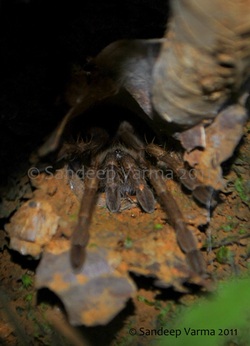Spiders are ancient creatures with an evolutionary history over 350 million years. Abundant and widespread in almost all ecosystems, they constitute one of the most important components of global biodiversity. They are also known to control the pests in different agro landscapes, thereby possessing great importance in the eco-system. Although there are more than 1400 species of spiders described from India, studies on spiders is still at grass root level.
It all started as a mere statement when I visited ARRS back in October 2010. Neeti Mahesh, greatly interested in spiders, suggested creating this basic inventory on spiders around ARRS.
Being rookies in arachnid studies, didn’t hold us back and after having finally gotten around to writing a proposal for the checklist, I and my friend Gokul Vinayan arrived on February 22 and kick started a preliminary recce over a week.
We decided to use the five days on field to spot and identify dominant or common species during this time of the year around ARRS. With plenty of help from ARRS team, especially education officer Naren Sreenivasan, we could identify over 30 species of spiders in less than the duration of our stay.
Spider diversity varies by seasons, ie., dominancy of spider species in a particular environment changes by season. Certain species of spiders are found during the summer in a particular environment, while some others are dominant during the monsoons or winter.
Plans are afoot to come back and improve upon the checklist after a few months, which will be the start of the monsoons in Agumbe, forcing different species of spiders to occupy the environment.
It all started as a mere statement when I visited ARRS back in October 2010. Neeti Mahesh, greatly interested in spiders, suggested creating this basic inventory on spiders around ARRS.
Being rookies in arachnid studies, didn’t hold us back and after having finally gotten around to writing a proposal for the checklist, I and my friend Gokul Vinayan arrived on February 22 and kick started a preliminary recce over a week.
We decided to use the five days on field to spot and identify dominant or common species during this time of the year around ARRS. With plenty of help from ARRS team, especially education officer Naren Sreenivasan, we could identify over 30 species of spiders in less than the duration of our stay.
Spider diversity varies by seasons, ie., dominancy of spider species in a particular environment changes by season. Certain species of spiders are found during the summer in a particular environment, while some others are dominant during the monsoons or winter.
Plans are afoot to come back and improve upon the checklist after a few months, which will be the start of the monsoons in Agumbe, forcing different species of spiders to occupy the environment.


 RSS Feed
RSS Feed
